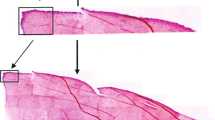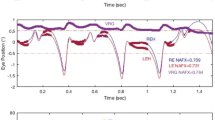Summary
The winter flounder,Pseudopleuronectes americanus, is mildly hyperopic. However, chromatic aberration exists in significant amounts and therefore the eye may be emmetropic (zero refractive error) in natural conditions when light is restricted to shorter wavelengths. Large accommodative lens motion was observed along the direction of the pupil axis. This direction is rare among the teleosts and is the result of the unusual split origin of the retractor lentis muscle. While the lens is spherical, as in other teleosts, the retina is not uniformly distant from the lens. Rather, a vertical asymmetry exists such that dorsal and ventral portions of the retina are further from the lens than the central retina. In view of the existing large accommodative ability, this distortion of the globe is not likely to have an optical function but is probably due to the shape of the cartilagenous scleral cup supporting the eye in its extraorbital location. Further, the lens is overcorrected for spherical aberration so that rays passing through the periphery of the lens are focused further away. The value of a lens of this type is unclear.
Similar content being viewed by others
References
Charman WN, Tucker J (1973) The optical system of the goldfish eye. Vision Res 13:1–8
Franz V (1931) Die Akkommodation des Selachierauges und seine Abblendungsapparate, nebst Befunden an der Retina. Zool Jahrb Abt Allgem Zool Physiol Tiere 49:323–462
Munk O (1971) On the occurrence of two lens muscles within each eye of some teleosts. Vidensk Medd Dan Naturhist Foren 134:7–19
Pumphrey RJ (1961) Concerning vision. In: Ramsay JA, Wigglesworth VB (eds) The cell and the organism. Cambridge University Press, London, pp 193–208
Sadler JD (1973) The focal length of the fish eye lens and visual acuity. Vision Res 13:417–423
Schwassmann HO, Meyer DL (1971) Refractive state and accommodation in the eye of three species ofParalebrax (Serranidae? Pisces). Vidensk Medd Dan Naturhist Foren 134:103–108
Sivak JG (1973) Interrelation of feeding behavior and accommodative lens movements in some species of North American freshwater fishes. J Fish Res Board Can 30:1141–1146
Sivak JG (1974) The refractive error of the fish eye. Vision Res 14:209–213
Sivak JG (1975) Accommodative lens movements in fishes: movement along the pupil axis vs. movements along the pupil plane. Vision Res 15:823–828
Sivak JG (1976a) The accommodative significance of the “ramp” retina of eye of the stingray. Vision Res 16:945–950
Sivak JG (1976b) Accommodative mechanisms in aquatic vertebrates. In: Ali MA (ed) Vision in fishes. Plenum, New York, pp 289–297
Somiya H, Tamura T (1973) Studies on the visual accommodation in fishes. Jpn J Ichthyol 20:193–206
Sroczynski S (1976) Die chromatische Aberration der Augenlinse der Regenbogenforelle (Salmo gairdneri Rich). Zool Jahrb Abt Allg Physiol Tiere 80:432–450
Sroczynski S (1977) Spherical aberration of crystalline lens in the Roach,Rutilus rutilus L. J Comp Physiol 121:135–144
Walls GL (1942) The vertebrate eye and its adaptive radiation. Cranbrook Institute of Science, Bloomfield Hills, Michigan
Author information
Authors and Affiliations
Rights and permissions
About this article
Cite this article
Sivak, J.G. Optical characteristics of the eye of the flounder. J. Comp. Physiol. 146, 345–349 (1982). https://doi.org/10.1007/BF00612704
Accepted:
Issue Date:
DOI: https://doi.org/10.1007/BF00612704




